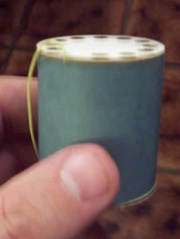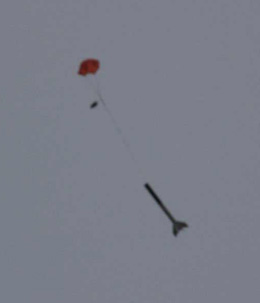| Construction Rating: | starstarstarstarstar_border |
| Flight Rating: | starstarstarstarstar_border |
| Overall Rating: | starstarstarstarstar_border |
| Diameter: | 1.64 inches |
| Manufacturer: | Semroc  |
| Skill Level: | 2 |
| Style: | Clone, Sport |
 Brief:
Brief:
This rocket is a retro-repro, 18mm, standard 4FNC rocket with baffle ejection and dual parachute recovery system.
Construction:
The balsa sheet was within the instructions and was broken in many places parallel to the grain. One fin was broken
into 2 pieces, the other three were broken into three pieces each. Let me hasten to add, I am NOT blaming Semroc for
this. This rocket was sitting near the bottom of a rather substantial pile of other level one rockets. I suspect that
is was my own careless handling that caused this.
Since other reviewers have listed the individual parts, I will not do so again. Construction was supposed to begin with the traditional motor mount. For me, construction began with my attempts to repair the broken fins. Fortunately, all the breaks were very clean. I used thin CA and they were soon ready to go and probably stronger than before.
Will that done, all the parts were present and accounted for and I was ready to begin in earnest. That brings us back to the motor mount. It was a farily standard affair. The hook is set in the provided slit and taped into place. A thrust ring is glued into the forward end and the centering rings are glued into place.
Next up was assembly of the ejection baffle. This is the first baffle I have ever tried to build or use. It comes
as a standard part of the kit. The two baffle rings are removed from their sheet and the hole are punched out. The
forward baffle also has a small slit which is used to fasten the shock cord. The supplied cord is a length of sewing
elastic. It is not particularly long but certainly servicable. I decided to use 2 feet of Kevlar®
to attach to the baffle. This was not because I doubted the baffle's ability to work. I just like long recovery trains.
I will use the elastic as well.
 The Kevlar®
was fed through the hole and knotted a few times to prevent it from pulling through. The tail was then laid flat across
the back of the baffle and glued down with yellow glue. I gave it a couple of coats.
The Kevlar®
was fed through the hole and knotted a few times to prevent it from pulling through. The tail was then laid flat across
the back of the baffle and glued down with yellow glue. I gave it a couple of coats.
Then there is the matter of gluing the baffles to the ends of the coupler tube. This was done with yellow glue as well. I was interested to see that the baffles sit on the shoulder of the coupler and not within it. This makes sense but I had always pictured in my mind that they sat within.
The rocket airframe consists of two tubes connected to each otehr by means of the coupler housing the baffle. Care must be taken so that the baffles are centered correctily and the coupler will actually fit into the BTs. Once they fit, it is an easy matter to glue the two sections together. Two things need to be remembered. The direction of the the baffle and therefore the shockcord matters. Also, the instructions suggest laying the assembled airframe down and rolling it around once it is assemble to make sure it is straight.
 According to the instructions, the next step is to mount the
fins. Since I wanted to use my Art Rose fin jig, I elected to install the motor mount first. The jig depends upon the
motor mount to recieve the mandrel. Some glue was swabbed in, the mount pushed part of the way in, some more glue
placed and the mount was slid home.
According to the instructions, the next step is to mount the
fins. Since I wanted to use my Art Rose fin jig, I elected to install the motor mount first. The jig depends upon the
motor mount to recieve the mandrel. Some glue was swabbed in, the mount pushed part of the way in, some more glue
placed and the mount was slid home.
I need not have bothered with the jig. I did not set the screws properly and the result was an abomination. It will no doubt fly and is probably not too noticable from a distance but looking at the result makes me cringe. It reminds me of some of my worst effots as a kid.
Finishing:
Despite my disappointment with the fins, I plugged away at the Centurion. The rocket was filled and sealed with
Elmer's FNF®
and then sanded smooth. I then primed it with two coats of white and gave it another sanding.
 The sanding was followed by 2 coats of gloss white which went down smoothly
enough. When the white had a chance to dry, I masked the lower body from the coupling of the 2 BTs and sprayed the
upper body with gloss black. I gave the upper body 2 coats as well.
The sanding was followed by 2 coats of gloss white which went down smoothly
enough. When the white had a chance to dry, I masked the lower body from the coupling of the 2 BTs and sprayed the
upper body with gloss black. I gave the upper body 2 coats as well.
When I peeled back the masking, I was both elated and disappointed. I was elated because, for the first time, I had gotten a perfect masking. There was no leakage at all and the change was crisp and professional. That bummed me out because it seemed wasted on a rocket whose fins I had hashed so badly.
The decals are a simple affair but they are very effective. They consisted of 2 Centurion logos and 4 red stripes. The Centurion logos went on just fine. The decal material is of good quality and I had no problems. The stripes were a bit different.
Two of the stripes are intended to be joined together to make one circuit about the BT just below the black paint. There is more than enough material to do so. The other two stripes are to be placed on either side of a single fin. They were long for the purpose and had to be trimmed to fit.
If I had my choice, the wrap around stripe would have been a single unit and the fin stripes would have been the right length to begin with. That may be picky but it is my opinion. The decals improved the look of the rocket marvelously.
Construction Rating: 4 out of 5
 Flight:
Flight:
The recommended motors for this rocket are the A8-3, B6-4 and C6-5. I decided to start small as is my usual practice.
I loaded up an A8-3. That was not the best of choices. I also added a bit of dog barf since this was my first
experience with a baffle. It climbed to a startlingly low altitude, stopped and started to come down. About 20 feet up,
the ejection charge went off but the chute did not have time to open. I got a nice little core sample but there was no
real damage.
The second flight was on a B6-4. This was a good flight. It went up straight, the chute deployed at apogee and it came down gently. This time I tried it without any dog barf and the baffles worked fine.
The third flight was on a C6-5. This too was a good flight and recovery. It had a bit of weathercocking but landed near the pad.
 Recovery:
Recovery:
This rocket should not be flown on an A motor... period. I should have been able to figure that out for myself. That
being said, it does well on a B and very well on a C. The baffle works great and the rocket looks good... if you get
the fins on right. I didn't, but it still flew well.
PROs: good launch, easy prep
CONs: A8-3 does not belong on the motor list.
Flight Rating: 4 out of 5
Summary:
This is a nice rocket. It looks good and is easy to build. It is fairly forgiving and fles great.
Overall Rating: 4 out of 5
Other Reviews
- Semroc Centurion By Ron Wirth (July 12, 2007)
Brief: The Centurion is another nice addition in the Semroc Retro-Repro series of rockets. For being a 4FNC rocket, it has some cool extras, namely the dual chutes, ejection baffle and shape of the laser cut fins that lead me to purchasing this rocket. I really like the curved portion of the fin at the rear of the rocket. Construction: This kit comes with 2 sections of body ...
- Semroc Centurion By Chan Stevens (June 7, 2007)
Brief: The original Centurion was introduced in 1970 by Centuri and was one of the first rockets to introduce an ejection baffle system, eliminating the need for recovery wadding. This is good for long, slow flights, and a nice flier. Construction: The parts list: Balsa nose cone 2 ST-16 body tubes 4 Laser-cut balsa fins 18mm motor kit 2 12" plastic ...
- Semroc Centurion By Bill Eichelberger (May 31, 2007)
Brief: Originally a Centuri kit circa 1971-77, the Centurion was perfectly sized to fit in with the Estes Big Bertha and Semroc Vega. With 18mm power and an ejection baffle that all but eliminated the need for recovery wadding, the Centurion was another choice in the crowded field of skill level one birds that were perfect for flights from smaller fields. The Semroc version also ...
 |
 |
Flights
 |
 |
Sponsored Ads
 |
 |











H.C.M. (June 18, 2007)